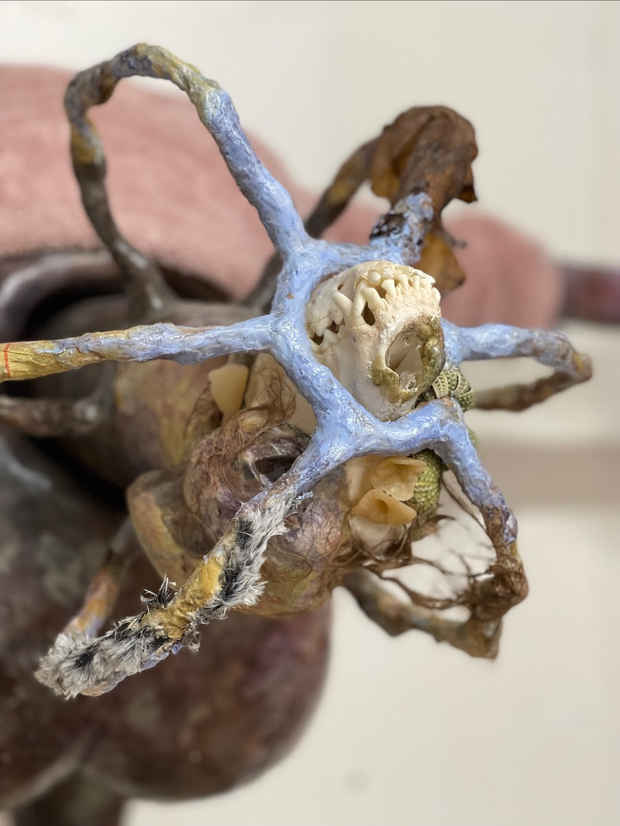Catalina Ouyang “White Male Ally”
Lyles & King (19 Henry St.)

[Image: Catalina Ouyang "force of will (dog self)" (2019-21) (detail)]
This event has ended.
Lyles & King presents White Male Ally, Catalina Ouyang’s second solo exhibition with the gallery. The exhibition will inaugurate the gallery’s new exhibition space at 19 Henry Street and occupy the outdoor sculpture space.
A 1958 magazine cover commemorates Fido, a dog who famously waited for fourteen years at his deceased owner’s bus stop. The cover depicts Fido on his dying day: lying on a dirt road, summoning just enough strength to prop himself up and look back toward the departing bus. What of such cultural lionization—entreating precious sentiment somewhere between admiration and pity, toward a creature rendered so wretched? What of fame for such fateful fidelity—memorialized in magazines, petrified on a pedestal for his obedience, waiting for a dead man to disembark?
White Male Ally portends waiting forever for master’s bus, a vehicle already spun out and flipped. This post-disaster space agitates compass and coordinates, continually reorienting the voyaging body. In Recourse (2021), a bus ceiling escape hatch is suspended on its side, restored to a vertical axis. A collapsed centaur traverses the emergency portal, its liminal body a fulcrum around which multiple dimensions pivot. The creature’s frosted skin glows baby blue-violet, and its posture suggests either repose or death. Behind it, one thousand arrows pierce the courtyard fence, alluding to Sagittarius the archer—the sun sign of the artist’s mother—in the entropic aftermath of aggression.
Here, there is architecture. The installation Ego Death (2021) spans the entire length of the gallery: a ceramic-tiled, three-foot-high platform punctuated by open toilet stalls built over a single trench. The trench toilet, common in 1980-90s China, lacks doors and precludes its users’ privacy. Inciting notions of shame and cultural metrics surrounding shame, the open-ended boxes mutate between stall and stage. The winding trench ends in a trapping pit: originally a tool for hunting animals, later a weapon in border conflicts and colonial invasion. This architectural fission insists that the logic of walls has never been neutral.
Here, there is reflection. Sculptures of suspended puppies with their backs turned to the viewer confront their likeness in a sequence of mirrors and inky resin casts. Below them, engraved plaques borrow an Englishman’s internal tirade from Jean Rhys’ Wide Sargasso Sea, in which he denounces his Creole wife as a witch and a slut: a microcosm of colonial discourse ascribed to annexed land and body. The passages crystallize the acute moment of falling irrevocably out of love. Other contorted forms populate the space, internalizing to the point of implosion. Recalling the mysterious beauty of a mobius strip, the form(less) autophagy entices more than it disgusts.
Here, there is devotion. In reliquary corpus (lash of hope) (2021), small gestural objects nest within the incised cavity of their wood-carved reliquary device. Relics spliced from their source contain no less magic than the whole body. font VIII (2021) continues a series in which the artist uses stone and organic materials to revise the form of the holy water vessel, this time transmuting a 17th-century marble font collected from a demolished church. Stolen marble from a different colonialist source—the Skull and Bones Society at Yale University—is hand-carved into a listening device in The Passion (2021), which frames this haunted material in relation to Clarice Lispector’s account of a mystical existential crisis. Finally, the installation Devotion (2016-2021)—not quite shrine, not quite tableau—weighs down the room with the face of an abusive lover, painfully and faithfully rendered in graphite. A scratched-up school desk situates a bruise-skinned girl in an educational setting, where lessons on loyalty come from an ambiguous mix of instruction and institutionalization, discipline and indoctrination.
Seeking the phrase “white male ally” in this work typifies the non sequitur, the literary device of disruption or unrelatedness: it does not follow. But the phrase also operates as a non sequitur in the philosophical sense. “White male ally” is a logical fallacy—its truth relies upon the assumption of its own truth. While the conclusion does not necessarily follow from the premise, logical turns and sleights of hand obfuscate this paradox and prop up its claim to truth without assumption. “White male ally” betrays cognitive dissonance and deceit at a structural level, whose invalidity is only inconsistently made apparent.
The world of White Male Ally resists the certainty of permanence: its edges are never made apparent, and the gestalt slips in and out like a tide. The exhibition is a continuation of the worldbuilding that propels Ouyang’s practice, in its endeavor to indicate counter narratives around representation and self-definition. Ouyang engages object-making, interdisciplinary environments, and time-based projects to examine themes of desire, subjugation, and dissidence. The artist’s intuitive use of organic, inorganic, and conceptual material is simultaneously poetic, apocalyptic, primordial, and abject. Using form, movement, and relational engagement either to expand or fragment subjectivity, the works propose the body as a politicized landscape subject to partition.
The address of Ouyang’s work can be described by means of triangulation: its origins begin at a known point, one potentially far away and long ago, from which measurements and approximations unfold outward to reach a desired unknown. The contours of labored estimations between distant origin and the object at hand form a sinuous network enveloping the work like microclimates, simultaneously the most ancient and the most subject to change. At times, the work thrives feeding off its local smog and becomes more difficult to elucidate. Sometimes, however, those same contours shimmer, like spiderwebs in the sun, casting the work in a subtly different light. For they have been a tragic love letter all along, with words that speak to those who have already inhabited the world after the crash and found meaning there.
—Marisa Espe
Media
Schedule
from September 01, 2021 to October 16, 2021
Opening Reception on 2021-09-01 from 18:00 to 20:00